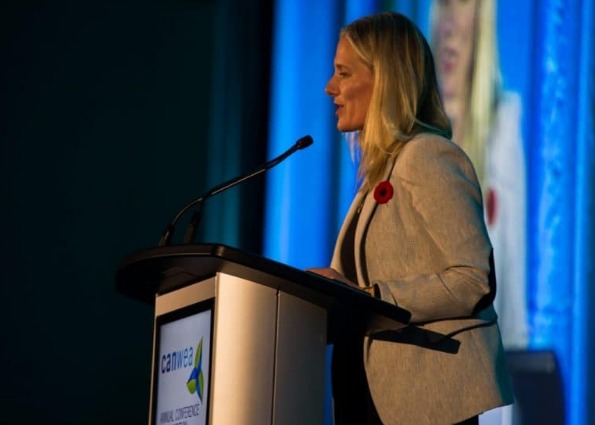The Canadian federal government has announced that it will source 100% of the electricity for its buildings and operations from renewable energy sources as part of its commitment to reduce greenhouse-gas emissions 40% by 2030.
Catherine McKenna, the federal minister of environment and climate change, announced the new commitments at the Canadian Wind Energy Association’s (CanWEA) 32nd Annual Conference and Exhibition in Calgary on Wednesday.
According to CanWEA, McKenna delivered a keynote luncheon address specifically focused on the government’s efforts to tackle climate change and the critical role clean energy technologies, such as wind energy, must play.
“We are taking action on climate change by greening our government’s activities and are doing our part to make further progress towards Canada’s emissions target,” says McKenna in a release. “We will do more as we develop our pan-Canadian climate plan – a plan that will create good jobs for the benefit of Canadians, especially the middle class and those striving to join it.”
According to a government release, although the emissions-reduction target is set for 2030, the Treasury Board of Canada Secretariat, along with federal departments and agencies, will work to achieve this 40% reduction as early as 2025. By that date, Public Services and Procurement Canada – the government’s principal landlord – will be purchasing 100% of its electricity from clean energy sources.
The government states that its Department of National Defense will be purchasing a significant amount of renewable electricity for its installations in Alberta – enough to meet most of its electricity requirements for installations in Calgary, Cold Lake, Edmonton, Wainwright and Suffield.
The release also notes that a new group is being established – Centre for Greening Government – that will track emissions centrally, coordinate efforts across government and drive results to make sure these objectives are met.
Although the release does not offer any specific plans to achieve the renewables goal, it states that progress toward emissions reduction will be achieved by strategic investments in infrastructure and vehicle fleets, green procurement, and support for clean technology.
The government notes that it has already committed $2.1 billion in Budget 2016 for repairs and retrofits to a wide range of government buildings and to the greening of government operations.
Robert Hornung, president of CanWEA, says, “[This] announcement by the federal government that it will source 100 percent of the electricity for its operations from renewable energy provides more evidence that federal and provincial governments are accelerating their efforts to address the risks of climate change.”
“We applaud the federal government for this new commitment, and we remain confident that wind energy will continue to be a key component of Canada’s efforts to reduce greenhouse-gas emissions,” he adds.
Complementing McKenna’s address, Wednesday’s CanWEA program discussed the technical, policy and market drivers that are shaping Canada’s evolving energy industry. Because of its low cost and zero emissions, wind energy appears a leading source of permanent, large-scale and affordable greenhouse-gas reductions, strategically positioned to make the deep carbon cuts required for Canada’s international climate obligations.
CanWEA says wind energy will be an important player in cleaning electricity grids in Alberta and Saskatchewan, and clean electricity grids will be needed for reducing fossil fuel use in other sectors through electrification and in the U.S. through clean energy exports.
“CanWEA 2016 has seen a lot of interest from investors, project developers, equipment suppliers and service providers who see real opportunity in Canadian wind energy – especially as Alberta and Saskatchewan move to grow wind energy production in a big way,” comments Larry Turner, president and CEO of Hannover Fairs, in a release.
In addition to high-level policy discussions and market analysis, Wednesday’s conference sessions also gave delegates a chance to gain insight into the science of assessing wind as a resource, data-driven strategies to improve project performance, models of community engagement and the evolution of storage technologies.
Photo courtesy of Bryan Passifiume/CanWEA – Hon. Catherine McKenna, federal minister of environment and climate change, delivers a keynote address during CanWEA’s 32nd Annual Conference and Exhibition in Calgary on Nov. 2.




